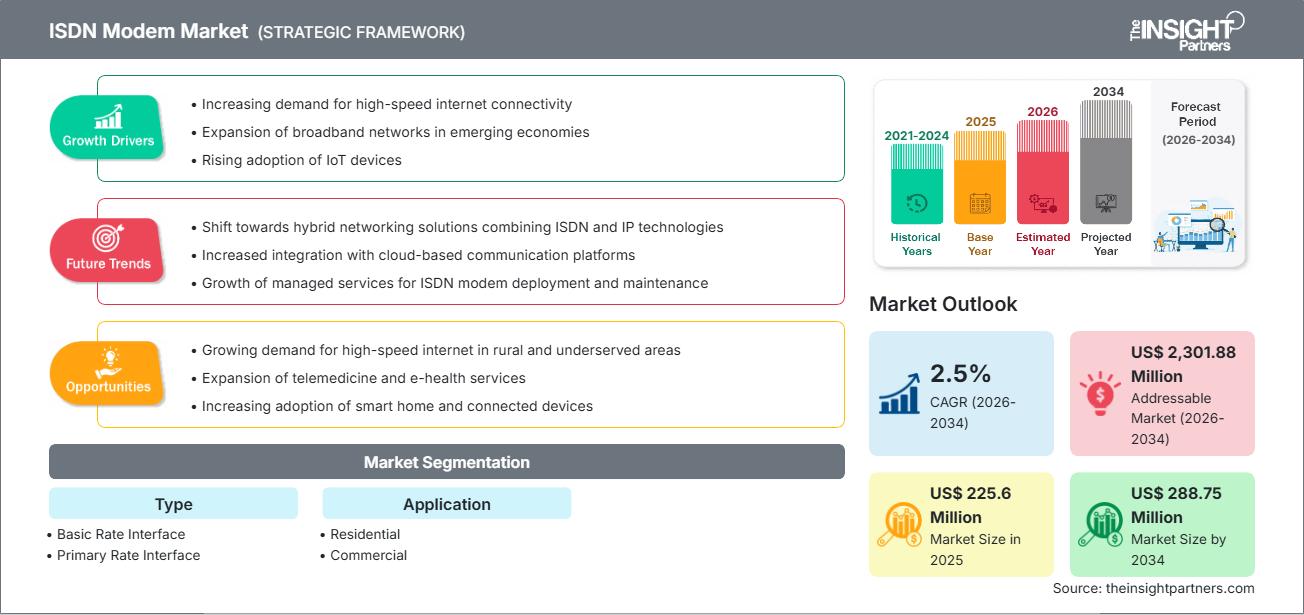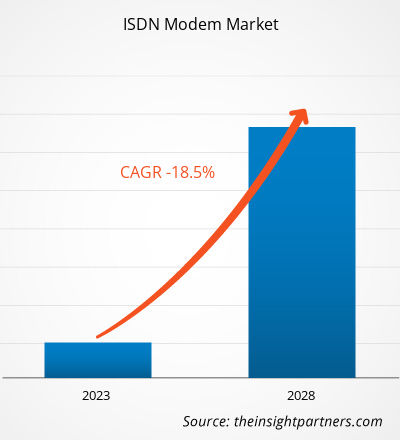Si prevede che il mercato dei modem ISDN passerà da 225,6 milioni di dollari nel 2025 a 288,75 milioni di dollari entro il 2034, con un CAGR del 2,5% nel periodo di previsione.
Analisi del mercato dei modem ISDN
Le previsioni per il mercato dei modem ISDN indicano una contrazione, trainata principalmente dal rapido passaggio dalle infrastrutture ISDN legacy alle tecnologie di comunicazione basate su IP e alla banda larga. Tuttavia, permane una domanda di nicchia per i modem ISDN in alcune regioni e casi d'uso, soprattutto come backup per le infrastrutture di telefonia legacy, nei mercati sottosviluppati o tra le aziende che continuano a fare affidamento su linee voce o dati basate su ISDN per affidabilità e sicurezza.
Il calo dei costi di modernizzazione e sostituzione delle infrastrutture ISDN, unito alle pressioni sui costi per la manutenzione delle reti più vecchie, sta spingendo decisamente al ribasso il mercato. Detto questo, alcuni operatori continuano a innovare con modem ISDN dotati di compatibilità ibrida, design modulare e profili energetici efficienti per servire una base in calo ma persistente.
Panoramica del mercato dei modem ISDN
I modem ISDN (Integrated Services Digital Network) sono dispositivi di comunicazione che consentono la trasmissione digitale di voce, video e dati su linee telefoniche tradizionali in rame. Supportano canali B per dati/voce e un canale D per la segnalazione, fornendo in genere una velocità di trasmissione fino a 128 kbps per BRI (Basic Rate Interface). I modem ISDN sono storicamente importanti per applicazioni vocali multilinea, dati, telefonia sicura e comunicazioni aziendali strutturate. Con la transizione di operatori e aziende al VoIP e alla banda larga, i modem ISDN rimangono rilevanti principalmente nei sistemi legacy, nelle linee di backup e in specifici ambienti regolamentati.
Personalizza questo report in base alle tue esigenze
Riceverai la personalizzazione gratuita di qualsiasi report, incluse parti di questo report, analisi a livello nazionale, pacchetto dati Excel e potrai usufruire di fantastiche offerte e sconti per start-up e università.
Mercato dei modem ISDN: approfondimenti strategici

-
Scopri le principali tendenze di mercato di questo rapporto.Questo campione GRATUITO includerà analisi dei dati, che spaziano dalle tendenze di mercato alle stime e alle previsioni.
Driver e opportunità del mercato dei modem ISDN
Fattori trainanti del mercato:
- Dipendenza dalle infrastrutture legacy: alcune organizzazioni e reti di telecomunicazioni continuano a fare affidamento sull'ISDN per affidabilità e connettività multi-linea a bassa latenza.
- Richiesta di connettività di backup: nelle regioni o nelle aziende in cui la banda larga è meno affidabile o non disponibile, le linee ISDN fungono da opzione di fallback o ridondanza.
- Comunicazioni regolamentate e sicure: la comunicazione basata su circuito ISDN può essere percepita come più sicura o deterministica in alcuni settori regolamentati, il che ne sostiene un caso d'uso di nicchia.
Opportunità di mercato:
- Sviluppo di sistemi ibridi: i fornitori di modem ISDN potrebbero avere l'opportunità di progettare modem ibridi che si interfacciano sia con reti ISDN che IP, soddisfacendo le esigenze delle organizzazioni che stanno lentamente migrando.
- Mercati emergenti e utilizzo rurale: nelle regioni in via di sviluppo o nelle aree rurali in cui le nuove infrastrutture a banda larga sono ancora in fase di sviluppo, le linee ISDN potrebbero persistere, aprendo la strada ai fornitori di modem per servire queste installazioni obsolete.
- Casi d'uso IoT e industriali: alcune applicazioni IoT o industriali che richiedono connessioni stabili, a bassa velocità e a commutazione di circuito potrebbero sfruttare l'ISDN in implementazioni specializzate.
Analisi della segmentazione del rapporto di mercato dei modem ISDN
Nei tipici report di ricerca di mercato (simili alla struttura di The Insight Partners), il mercato dei modem ISDN può essere segmentato come segue:
Per tipo:
- Interfaccia di velocità di base (BRI)
- Interfaccia di velocità primaria (PRI)
Per applicazione:
- Uso residenziale
- Uso commerciale/aziendale
Per geografia:
- America del Nord
- Europa
- Asia Pacifico
- Medio Oriente e Africa
- America meridionale e centrale
Approfondimenti regionali sul mercato dei modem ISDN
Le tendenze e i fattori regionali che hanno influenzato il mercato dei modem ISDN durante il periodo di previsione sono stati ampiamente spiegati dagli analisti di The Insight Partners. Questa sezione analizza anche i segmenti e la geografia del mercato dei modem ISDN in Nord America, Europa, Asia-Pacifico, Medio Oriente e Africa, America Meridionale e Centrale.
Ambito del rapporto sul mercato dei modem ISDN
| Attributo del report | Dettagli |
|---|---|
| Dimensioni del mercato nel 2025 | 225,6 milioni di dollari USA |
| Dimensioni del mercato entro il 2034 | 288,75 milioni di dollari USA |
| CAGR globale (2026 - 2034) | 2,5% |
| Dati storici | 2021-2024 |
| Periodo di previsione | 2026-2034 |
| Segmenti coperti |
Per tipo
|
| Regioni e paesi coperti |
America del Nord
|
| Leader di mercato e profili aziendali chiave |
|
Densità degli operatori del mercato dei modem ISDN: comprendere il suo impatto sulle dinamiche aziendali
Il mercato dei modem ISDN è in rapida crescita, trainato dalla crescente domanda degli utenti finali, dovuta a fattori quali l'evoluzione delle preferenze dei consumatori, i progressi tecnologici e una maggiore consapevolezza dei vantaggi del prodotto. Con l'aumento della domanda, le aziende stanno ampliando la propria offerta, innovando per soddisfare le esigenze dei consumatori e sfruttando le tendenze emergenti, alimentando ulteriormente la crescita del mercato.

- Ottieni una panoramica dei principali attori del mercato dei modem ISDN
Analisi della quota di mercato dei modem ISDN per area geografica
Ecco una ripartizione regionale ipotetica o dedotta e le tendenze chiave:
-
America del Nord
- Probabilmente detiene una quota significativa a causa delle storiche esigenze di infrastruttura ISDN e di continuità aziendale.
- Alcune aziende e call center utilizzano l'ISDN per le linee dati e vocali tradizionali.
-
Europa
- Quota moderata, con infrastrutture normative e obsolete che continuano a sostenere la domanda in determinati settori.
- Possibile enfasi sulle implementazioni ibride ISDN-IP.
-
Asia Pacifico
- Una quota più piccola ma rilevante, soprattutto nelle regioni in cui l'infrastruttura IP è ancora in fase di proliferazione o dove persistono linee di telecomunicazioni obsolete.
- Opportunità nei mercati rurali o in via di sviluppo.
-
Medio Oriente e Africa, Sud e Centro America
- Nicchia emergente per i modem ISDN nei sistemi di telecomunicazione tradizionali.
- Volumi complessivi inferiori ma importanza strategica per i fornitori di linee di backup o per l'uso da parte delle piccole aziende.
Densità degli operatori del mercato dei modem ISDN: comprendere il suo impatto sulle dinamiche aziendali
Il mercato dei modem ISDN è sempre più di nicchia e obsoleto, ma la concorrenza esiste ancora:
-
Fattori di differenziazione strategica:
- Compatibilità ibrida ISDN/IP
- Progetti modulari ed efficienti dal punto di vista energetico
- Bassa manutenzione, connettività legacy sicura
-
Impatto sulla concorrenza:
- Il calo del volume di mercato incoraggia il consolidamento o la specializzazione.
- I fornitori possono collaborare con gli operatori di telecomunicazioni nei mercati in cui permangono linee ISDN obsolete.
- Alcuni si stanno concentrando sui modem ISDN avanzati per uso specializzato o industriale piuttosto che sulle telecomunicazioni di massa.
Opportunità / Mosse strategiche per i giocatori:
- Sviluppare modem BRI/PRI convenienti e con funzionalità di linea di backup.
- Promuovere dispositivi ibridi modulari per le aziende che migrano al VoIP ma mantengono le linee ISDN per ridondanza.
- Esplorare i mercati emergenti in cui l'infrastruttura ISDN è ancora funzionale ma poco monetizzata.
I principali attori chiave del mercato:
- Ekinops
- TERRATEL
- Patton LLC
- A TLC Srl
- Epygi Technologies LLC
- Polycom
- Xiamen Yeastar Information Technology Co., Ltd.
- Ipermedia
- Reti Aristel
Altre aziende analizzate durante la ricerca:
- Adtran, Inc.
- DrayTek Corp.
- Robotica statunitense
- AVM GmbH
- Serie Fritz!Box (di AVM)
- Black Box Network Services, Inc.
- MultiTech Systems, Inc.
- Westermo Network Technologies AB
- 2NTelekomünikasyone as
- Belkin International, Inc.
Notizie e sviluppi recenti sul mercato dei modem ISDN
- Alcuni produttori di modem continuano a innovare: ad esempio, modem ibridi che combinano funzionalità ISDN e IP, o modelli ISDN a basso consumo energetico, per soddisfare la nicchia tradizionale.
- La domanda è limitata ma persistente nelle regioni con banda larga poco sviluppata o nelle aziende che si affidano all'ISDN per canali voce/dati ridondanti.
Copertura e risultati del rapporto sul mercato dei modem ISDN
L'ipotetico rapporto "Dimensioni e previsioni del mercato dei modem ISDN (2021-2034)" di The Insight Partners includerebbe:
- Previsioni sulle dimensioni del mercato a livello globale, regionale e nazionale, in tutti i segmenti chiave.
- Analisi approfondita delle tendenze e delle dinamiche del mercato (fattori trainanti, vincoli e opportunità).
- Analisi PEST e SWOT per aiutare a comprendere le forze macropolitiche, economiche, sociali e settoriali.
- Panorama competitivo: profili aziendali, concentrazione del mercato, analisi delle mappe di calore.
- Sviluppi recenti e mosse strategiche dei principali attori.
- Analisi storica (2 anni), anno base, previsione (7 anni) con CAGR
- Analisi PEST e SWOT
- Valore/volume delle dimensioni del mercato - Globale, Regionale, Nazionale
- Industria e panorama competitivo
- Set di dati Excel
Report recenti
Testimonianze
Motivo dell'acquisto
- Processo decisionale informato
- Comprensione delle dinamiche di mercato
- Analisi competitiva
- Analisi dei clienti
- Previsioni di mercato
- Mitigazione del rischio
- Pianificazione strategica
- Giustificazione degli investimenti
- Identificazione dei mercati emergenti
- Miglioramento delle strategie di marketing
- Aumento dell'efficienza operativa
- Allineamento alle tendenze normative






















 Ottieni un campione gratuito per - Mercato dei modem ISDN
Ottieni un campione gratuito per - Mercato dei modem ISDN